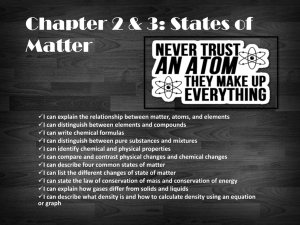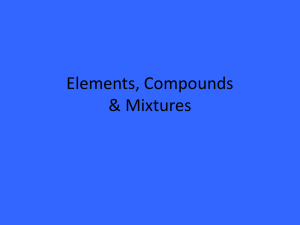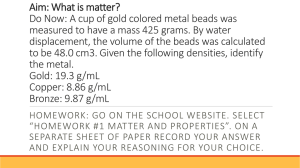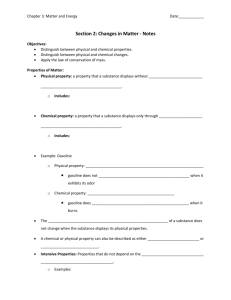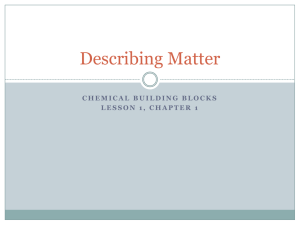Chapter 15 ppt.
advertisement
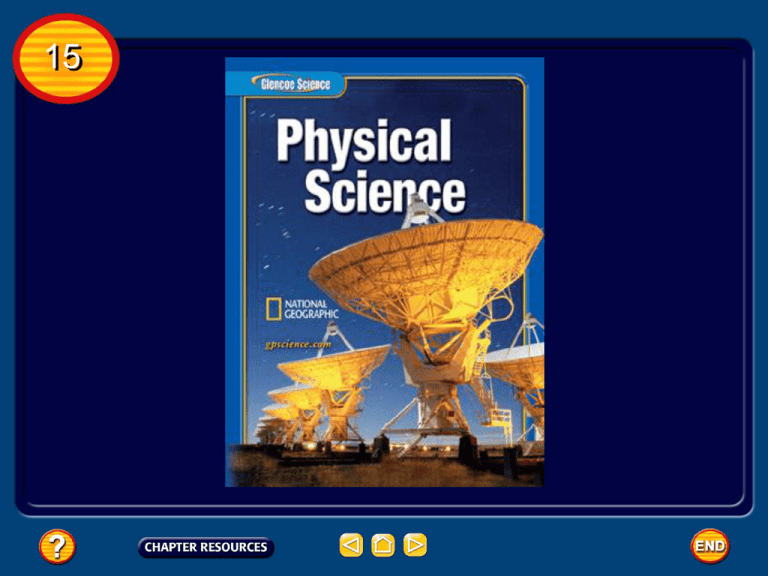
15 Table of Contents 15 Unit 4: The Nature of Matter Chapter 15: Classification of Matter 15.1: Composition of Matter 15.2: Properties of Matter Composition of Matter 15.1 Elements • All substances are built from atoms. • element – Pure Substance- all the atoms in a have the same identity • Examples: ? Composition of Matter 15.1 Elements • About 90 elements are found on Earth. • More than 20 others have been made in laboratories, but most of these are unstable and exist only for short periods of time. Composition of Matter 15.1 Compounds • Compound- two or more elements combine to form substances (has a specific chemical composition) • Examples? Composition of Matter 15.1 Compounds Composition of Matter 15.1 Mixtures • A mixture- Material made up of two or more substances that can be easily separated by physical means. • Examples? Composition of Matter 15.1 Heterogeneous Mixtures • heterogeneous mixture -A mixture in which different materials can be distinguished easily • Examples? Composition of Matter 15.1 Heterogeneous Mixtures Composition of Matter 15.1 Homogeneous Mixtures Composition of Matter 15.1 Homogeneous Mixtures • Homogeneous mixture two or more gaseous, liquid, or solid substances blended evenly throughout. • Examples? Composition of Matter 15.1 Homogeneous Mixtures • Solution – • (AKA- homogeneous mixture) • Particles cannot be seen with a microscope • Will never settle to the bottom of their container. Composition of Matter 15.1 Colloids • colloid -Mixture with particles that are larger than those in solutions but not heavy enough to settle out. • Not homogeneous or heterogeneous • Examples? Composition of Matter 15.1 Detecting Colloids • Tyndall effectscattering of light by colloidal particles Composition of Matter 15.1 Suspensions • suspension, which is a heterogeneous mixture containing a liquid in which visible particles settle. • Examples? Composition of Matter 15.1 Suspensions • The table summarizes the properties of different types of mixtures. Section Check 15.1 Question 1 A _______ is a type of matter with a fixed composition. A. colloid B. mixture C. substance D. solution Section Check 15.1 Answer The answer is C. A substance can be either an element or a compound. Section Check 15.1 Question 2 How many elements are found on Earth? A. 5 B. 10 C. 30 D. 90 Section Check 15.1 Answer The answer is D. About 90 elements are found on Earth, and more than 20 have been made in laboratories. Section Check 15.1 Question 3 How are compounds different from mixtures? Section Check 15.1 Answer The atoms in compounds are combined in fixed proportions and cannot be separated by physical means. A mixture is made of two or more substances that can be easily separated by physical means. Properties of Matter 15.2 Physical Properties • physical property - characteristic of a material that you can observe without changing the identity of the material. • Examples: color, shape, size, density, melting point, and boiling point. • Item Examples: Properties of Matter 15.2 Behavior Properties of Matter 15.2 Physical Change The Identity Remains the Same • physical change -A change in size, shape, or state of matter. • Examples? Properties of Matter 15.2 The Identity Remains the Same Properties of Matter 15.2 Using Physical Change to Separate • Distillation- Separating substances in a mixture by evaporating a liquid and recondensing its vapor Properties of Matter 15.2 Distillation Properties of Matter 15.2 Chemical Properties and Changes • chemical property- characteristic of a substance that indicates whether it can undergo a certain chemical change. • Examples? Properties of Matter 15.2 Detecting Chemical Change • If you leave a pan of chili cooking unattended on the stove for too long, your nose soon tells you that something is wrong. • This burnt odor is a clue telling you that a new substance has formed. Properties of Matter 15.2 The Identity Changes • chemical change - A change from one substance to another • Indications of chemical change: • Odor • Temperature Change • Formation of gas/solid • Color Click image to view movie Properties of Matter 15.2 The Conservation of Mass Properties of Matter 15.2 The Conservation of Mass • Law of conservation of mass, the mass of all substances equal the mass of all the substances that remain after the change. • no mass is lost during a chemical or physical reaction. Section Check 15.2 Question 1 Which of the following is a chemical property? A. boiling point B. density C. flammability D. melting point Section Check 15.2 Answer The answer is C. Flammability indicates whether a substance will undergo the chemical change of burning. Section Check 15.2 Question 2 A characteristic of a material that can be observed without changing the identity of the substances that make up the material is a _______. Section Check 15.2 Answer The answer is physical property. Examples of physical properties include color, shape, and density. Section Check 15.2 Question 3 What is the law of conservation of mass? Section Check 15.2 Answer According to the law of conservation of mass, the mass of all substances that are present before a chemical change equals the mass of all substances that remain after the change. 15 To advance to the next item or next page click on any of the following keys: mouse, space bar, enter, down or forward arrow. Click on this icon to return to the table of contents Click on this icon to return to the previous slide Click on this icon to move to the next slide Click on this icon to open the resources file. Click on this icon to go to the end of the presentation. End of Chapter Summary File





